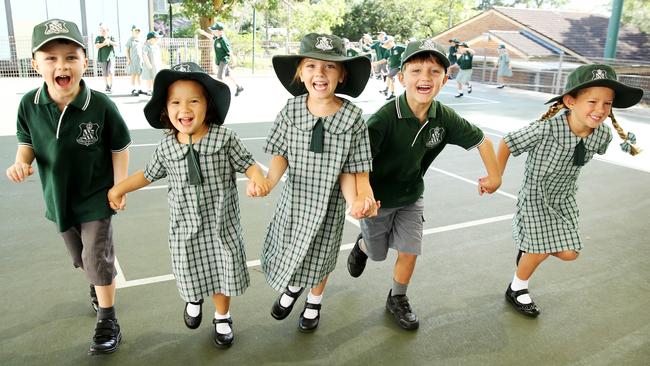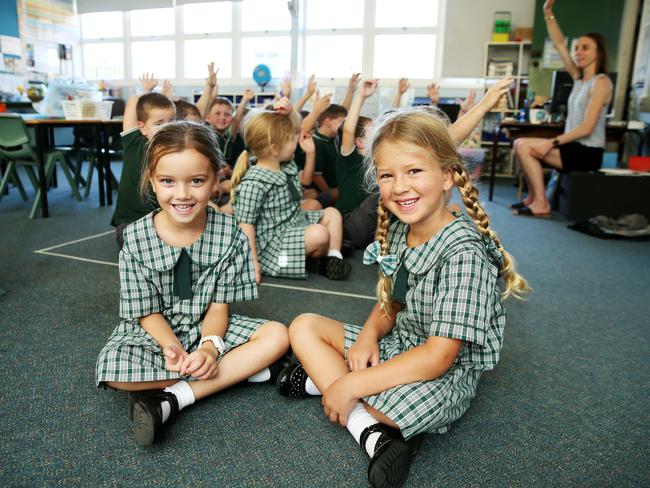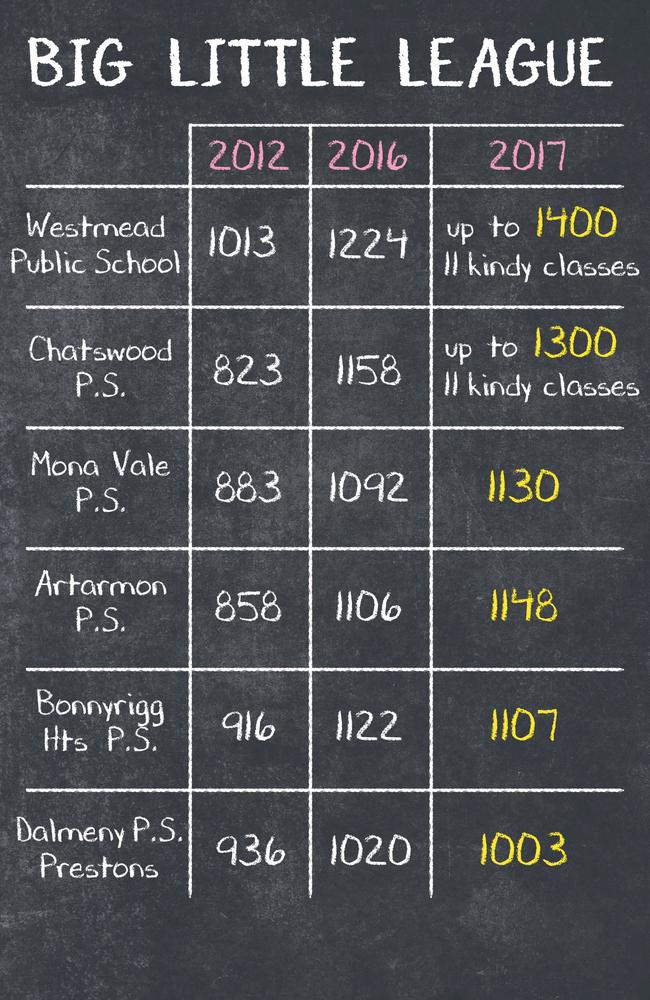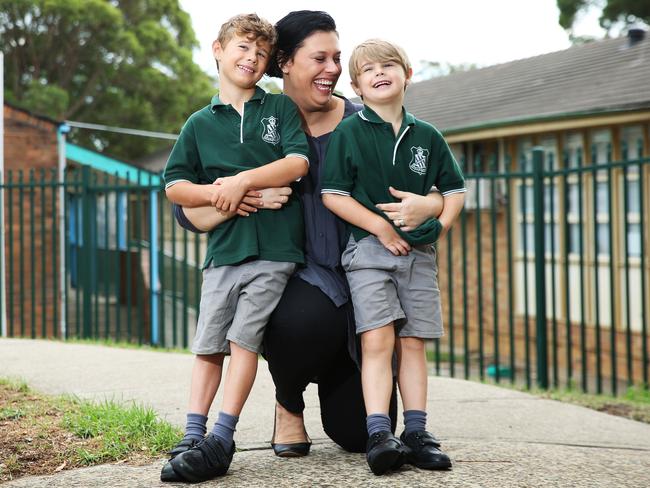NSW schools adopt new strategies to cope with burgeoning capacities
EXCLUSIVE: Primary schools struggling to cope with the massive intake of kindergarten pupils have been forced to stagger starting times and house as many as 11 classes in demountable rooms.

NSW
Don't miss out on the headlines from NSW. Followed categories will be added to My News.
PRIMARY schools struggling to cope with the massive intake of kindergarten students this year have been forced to stagger starting times while others are housing as many as 11 classes in demountable rooms.
With more than 1000 students in attendance, some primary schools are now bigger than high schools, with principals planning for a future of “vertical schools” to cope with the constant influx of pupils.
Primary schools at Westmead, Bonnyrigg and Cabramatta in Sydney’s west, Chatswood, Artarmon and Willoughby in the north, Mona Vale and Harbord on the northern beaches and Hurstville in the city’s south are among the state’s biggest schools and there is no sign of slowing down.

Westmead Public, which has up to 1400 pupils this year, has grown by almost 30 per cent since 2012.
The figures, which were given to the Education Department as part of 2017 census collation, come after a report last year showed more than 800 of the state’s 2182 schools were at 100 per cent capacity.
Some schools have cordoned off play areas so younger students aren’t mixing with older pupils, while some have staggered their lunch times to ensure all students have access to the playground.
The student boom has been driven partly by Sydney’s real estate boom. Young families struggling to get on the property ladder and looking to move to an area with good public schools have been financially forced into the same areas, resulting in gluts of new school-age kids.
Westmead principal David Jenkins said his school had 220 new kindergarten pupils.
“As they release more land in Warriewood there will be more pressure on schools in the area.”
“The trend has been increasing enrolments from kindy to year four. Westmead has a range of housing, both medium and high-density, so being on a railway line we have a wonderful reputation and people are drawn to us here,” he said.
“We are still receiving enrolments so we advised parents we will have temporary classes for the first four weeks, but we will have 11 kindy classes this year.
“There is a kindy area they play in and as time goes on they are exposed to the greater playground.”
Bonnyrigg Heights principal Darryl McKay said the school had 1107 students in 51 classes, with the largest grade having 191 pupils.
“We have been maintaining numbers for the past few years but it’s a very big school and my buildings are at capacity,” Mr McKay said.
“We split our playground so kindy to Year Two have recess half an hour earlier than the older kids.
“We have 24 demountable buildings and I’d love to get rid of every single one. There are provisions being sought so all the schools will be looked at in the future.
“And when it comes to kindy we have two teachers in the class to support the kids for the first three weeks.”
“The term ‘demountable’ has a negative connotation in the public perception but it shouldn’t — it’s just a modular classroom.”
Mona Vale principal Greg Jones said the school’s 1130 enrolments were as predicted, showing a growth of almost 22 per cent since 2012.
“It is a big school and we have had solid growth every year, and as they release more land in Warriewood there will be more pressure on schools in the area,” Mr Jones said.
“We treat the school as a junior and senior school, broken up into K-2 and 3-6 and we are the largest school in NSW by land area, so we have the capacity to grow, but we are always looking at intuitive ways to do that so are certainly exploring the capacity for double-storey demountables.”
Mr Jones said growing schools in NSW needed to scrap traditional classroom models and consider building vertically to maximise use of outdoor areas.

“Demountables are actually excellent accommodation — they are airconditioned, have wet areas and private teacher areas, a bag area — I think if you asked teachers, 99 per cent would prefer a brand-new demountable over existing stock that was built in the 1950s,” he said.
“The term ‘demountable’ has a negative connotation in the public perception but it shouldn’t — it’s just a modular classroom.
“For schools in consolidated areas there will be a constant push in enrolments because they are coming under more density. We need to consider building schools vertically so we can retain active space around them.
“We need students in two or three-storey buildings, and design schools to be much more modular so that as they grow we can just tack them on or contract as needed.”
He said Mona Vale also had rosters for each grade to use the popular play equipment areas “so big kids don’t knock over the little kids”.
“We will still struggle for playground space but it will be a great addition to the school.”
Artarmon principal Louise Green said their building project would be completed at the end of the year, giving the school an extra three-storey building with 21 new classrooms to help cope with the extra influx.
“The kindies have their own playground,” Ms Green said. “There are 154 of them over seven classes, so they need their own space so they don’t get overwhelmed.
“Towards the end of the year they can play on the oval with everyone else.
“We will still struggle for playground space but it will be a great addition to the school.”
Willoughby Public staggered kindy term dates for its eight classes and have asked parents to pick them up at 2.30pm for the next month to ease congestion at peak periods.
An Education Department spokesman said it would release all NSW public school enrolment data next month as part of its census collation.
SIZE MATTERS AS UPSIDES COUNTER DOWNSIDES
BIG schools have larger subject choice and greater access to resources. Small schools give pupils an increased sense of community and belonging, with families getting to know teachers and fellow pupils better.
Big or small, each has its advantages and opportunities, according to UNSW Professor of Educational Psychology Andrew Martin — it’s just whether they maximise them that counts.
“Different school sizes offer different opportunities,” Prof Martin said.

“So in a large school there may be a wider selection of subject choice, and also they may attract a certain level of funding which can allow more resources within the school.
“In smaller schools, most of the teachers are likely to know who you are by June, and we do find that the better teachers know a child, they better they can help them, so a smaller school may offer relational advantages — you get to know more students and your sense of belonging may be higher.
“They both offer unique opportunities — it’s whether they are properly leveraged that makes a difference.”
Mother of three, educator and careers adviser Bianca Tobia said her boys Brody, 6, and Aston, 5, loved their time at Mona Vale Public School — and so did she.
“The size of a school matters, but every student’s needs differ and are individualised,” she said.
“I wouldn’t say my opinion is a one size fits all, but what I would say is that for my kids, a larger school allows greater opportunity for them because there is the additional funding to cater to these needs as well as both my boys are complete opposites — the school caters to both their strengths and interests.
“For example, Brody is learning the violin this year and both my boys have sport lessons with specialised PE teachers.
“The school also offers external organisations contracted to teach languages, tennis, dance and scripture just to name a few.
“As big as the school is, it is a very family orientated environment so you don’t feel or really see how big it is because of the love and support my kids receive within the whole school community.”





